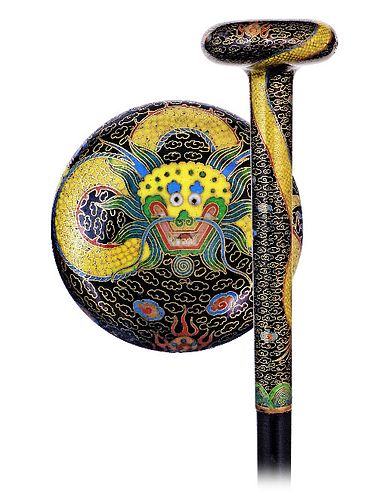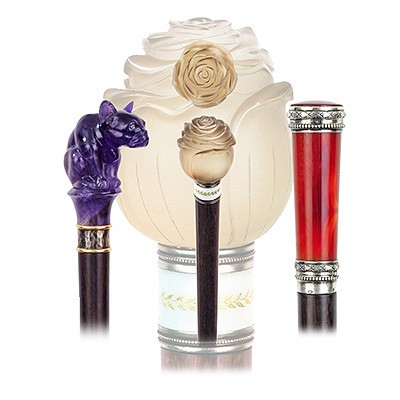Cloisonné Enamel Mascot Cane
Lot 3
About Seller
Kimball Sterling
125 West Market Street
Johnson City, TN 37604
United States
Family-owned and family-run Johnson City Tennessee auction business for 25 years. Selling antiques and collectables for 38 years. Kimball M. Sterling, Inc. was founded and is owned by Kimball and Victoria Sterling, time and again, they have laid solid claim to world-wide attention and renown with an...Read more
Categories
Estimate:
$800 - $1,200
Absentee vs Live bid
Two ways to bid:
- Leave a max absentee bid and the platform will bid on your behalf up to your maximum bid during the live auction.
- Bid live during the auction and your bids will be submitted real-time to the auctioneer.
Bid Increments
| Price | Bid Increment |
|---|---|
| $0 | $10 |
| $100 | $25 |
| $500 | $50 |
| $1,000 | $100 |
About Auction
By Kimball Sterling
Dec 3, 2022
Set Reminder
2022-12-03 13:00:00
2022-12-03 13:00:00
America/New_York
Bidsquare
Bidsquare : The 2022 Cane Masterpiece Auction
https://www.bidsquare.com/auctions/kimball-sterling/the-2022-cane-masterpiece-auction-11295
The European Masterpiece Cane Collection Kimball Sterling kimballsterling@earthlink.net
The European Masterpiece Cane Collection Kimball Sterling kimballsterling@earthlink.net
- Lot Description
-Ca. 1890 -Shippo enamel handle with a large, round and flat top and an integral long and cylindrical stem decorated with a yellow dragon on a black background with endless, partly colored clouds. The fabled animal shows a cartooned head with round eyes, large open mouth and long whiskers and erected hair and horns on the top of the flaring knob to extend on the opposite side and down on the stem with a stretched and scaled body with two paws and tufted tail. -Executed in the ancient and traditional Far-Eastern love for the detail perfection, the striking handle comes on a linear tapering ebony shaft with a hardly noticeable, wrapping around treaded pattern and a metal ferrule. -Decorative and agreeably light weighted, this lucky charm cane is of the highest grade of its kind, and, despite a great fragility, survived in flawless condition. -H. 5 ¾” x 2”, O.L. 40 ½” -$800-$1,200 -Cloisonné is a way of enameling an object, (typically made of copper) whereby fine wires are used to delineate the decorative areas (cloisons in French, hence cloisonné) into which enamel paste is applied before the object is fired and polished. -The Japanese characters used for the word shippo (the Japanese term for enamelware) mean “Seven Treasures” which is a reference to the seven treasures mentioned in Buddhist texts. Although these treasures may vary, they generally included at least some of the following: gold, silver, emerald, coral, agate, lapis lazuli, giant clamshell, glass and pearl. The Japanese applied this expression to the rich colors found on Chinese enamel wares and later to those they made themselves. -Dragons combine the characteristics of the four elements, earth, air, fire and water; they symbolize light and dark, the sun and moon, masculine and feminine, and the unity underlying these opposing forces. The dragon possesses the wings of a bird and the scales of a snake or fish. It breathes fire and often guards a hoard of treasure in its lair. In the East and in pre-Christian Europe the dragon was seen as helpful and kind - indeed, the red dragon is the emblem of Wales - but Christianity, which saw the serpent as a symbol of evil, also viewed the dragon as a creature of ill-omen, representing destructiveness and inner chaos. The Chinese Dragon is a symbol of the Emperor, of male energy and of fertility; it is a benign animal and the fifth creature of the Chinese zodiac. It guards the East and represents sunrise, spring, and the rains. Indeed, torrential rain is known as dragon rain. There are four types of dragons in Chinese legend: Dragons of the air, the earth, the water and the spirit.
- Shipping Info
-
Each auction has different shipping terms but the buyer always pays. Shipping will be delayed in this auction due to delay of customs.Canes:After payment has been received we will contact you.
- Buyer's Premium
-



 EUR
EUR CAD
CAD AUD
AUD GBP
GBP MXN
MXN HKD
HKD CNY
CNY MYR
MYR SEK
SEK SGD
SGD CHF
CHF THB
THB


















